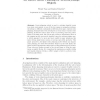Free Online Productivity Tools
i2Speak
i2Symbol
i2OCR
iTex2Img
iWeb2Print
iWeb2Shot
i2Type
iPdf2Split
iPdf2Merge
i2Bopomofo
i2Arabic
i2Style
i2Image
i2PDF
iLatex2Rtf
Sci2ools
124
Voted
DASFAA
2011
IEEE
2011
IEEE
3D Indoor Route Planning for Arbitrary-Shape Objects
Route planning, which is used to calculate feasible routes in a given environment, is one of the key issues in navigation systems. According to different constraints in different given space, various route planning strategies have been developed in recent years. Current route planning models for indoor space focus on providing routes for pedestrians or fix-sized users, like robots and persons in wheelchairs. None of the existing model can provide feasible routes for arbitrary-shape users, which appears to be more and more useful in many situations, like users driving small indoor autos or moving carts with products. This paper proposes a two-phase route planning model which can support route planning for users with arbitrary shapes. In the first phase, the LEGO model represents the entire space by using different types of cubes. These cubes are further merged in the second phase to form the maximum accessible blocks. By computing the maximum accessible widths and lengths between b...
Related Content
| Added | 20 Aug 2011 |
| Updated | 20 Aug 2011 |
| Type | Journal |
| Year | 2011 |
| Where | DASFAA |
| Authors | Wenjie Yuan, Markus Schneider |
Comments (0)

